
Current Research Activities
Currently we are focusing broadly on the following interdisciplinary areas of research in our laboratory:
(1) High-Resolution Gas-Phase Cavity Ring-Down Spectroscopy (CRDS) with Quantum Cascade Lasers (QCLs)
Cavity ring-down spectroscopy (CRDS) has recently become the method of popular choice for direct ultra-sensitive and quantitative absorption measurements of molecules in the gas phase. This is because of its insensitivity to laser intensity fluctuations along with the enormous path lengths (several km) through the sample that can be achieved. The method is based on the measurement of the rate of absorption rather than the magnitude of absorption of light circulating in a high-finesse optical cavity. Because of its novel optical approaches, the ring-down technique easily offers ≥ 10^5-10^6-fold better detection sensitivity than conventional multi-pass measurements.
 |
We have developed continuous wave (cw) CRDS and WMS techniques using widely tunable mode-hop-free (MHF) external cavity quantum cascade lasers (EC-QCL) in the mid-infrared molecular fingerprint region. The cw-CRDS measurements will provide important information about the line intensities, positions, line-shape coefficients and unresolved hyperfine structure in a relevant transition of several molecular species of interests. Moreover, high-resolution ro-vibrational measurements will allow simultaneous detection and precise quantification of many molecular species along with their isotopes in real-time. |
(2) Applications of High-Resolution Laser Spectroscopy for Biomedical Research and Medical Physics
Now-a-days CRDS and MS techniques have found widespread applications in life sciences, in particular in the field of biomedical research and clinical diagnostics. Currently we are focusing on the following three different problems:
(a) Non-invasive diagnosis of diabetes using human breath analysis:
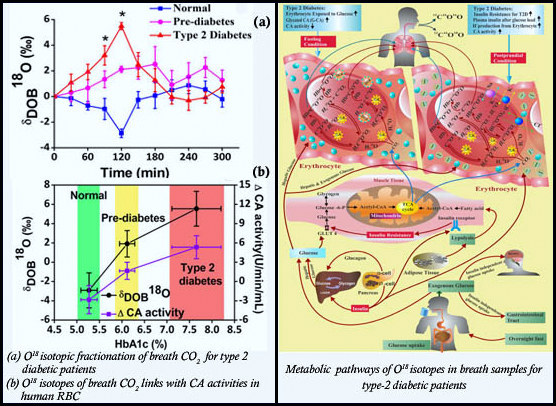 |
Type 2 diabetes mellitus is the most common deleterious metabolic disease in the 21st century and has become one of the most pressing human health concerns all over the world. Hence an accurate and fast practical diagnosis of pre-diabetes prior to the onset of type 2 diabetes remains a challenge. We are currently working to develop new-generation diagnostic methods using human breath analysis for non-invasive assessment of pre-diabetes and type 2 diabetes mellitus and eventually to explore its true potential for routine clinical practices without any painful blood sample measurements. We have shown here some of our recent experimental results on type 2 diabetes.
We also try to explore the possible metabolic pathways in the pathogenesis of type 2 diabetes. Recently we have also started working on type 1 diabetes using human breath analysis.
|
(b) Peptic ulcer, non-ulcerous dyspepsia and H. pylori infection:
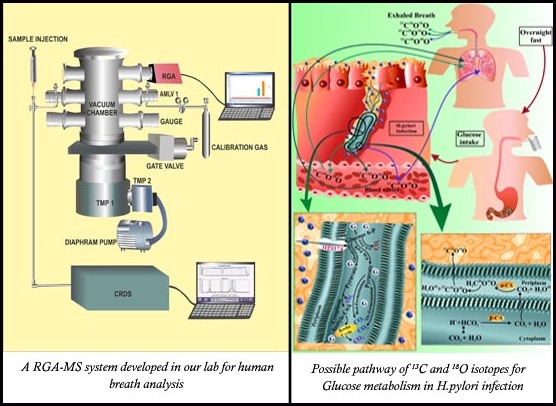 |
Helicobacter pylori(H. pylori) infection is the primary cause of gastritis and peptic ulcer diseases, and has been linked to the onset of various critical diseases such as stomach cancer, gastric lymphoma etc. The 13C-urea breath test (13C-UBT) is considered to be the most viable non-invasive method in the diagnosis of H. pylori infection by contrast with the direct invasive tests such as endoscopy and biopsy-based tests. At present we are working in the developments of new-generation diagnostic tools and methodologies which can precisely track the evolution of peptic ulcer and non-ulcerous dyspepsia related to H. pylori infection.
We have recently shown that O18 isotope of breath CO2 is potential bio-marker of H.pylori infection. We are also exploring some other molecular species in human breath which can be considered also the potential bio-markers in the diagnosis of peptic ulcer.
|
(c) Irritable Bowel Syndrome and Small Intestinal Bacterial Overgrowth:
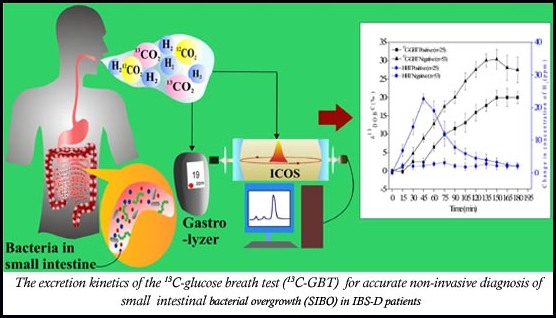 |
Small intestinal bacterial overgrowth (SIBO), a very common gastroenterological disorder, is usually characterized by an increased number or abnormal type of bacteria in the small intestine. Several evidences suggest that SIBO is closely associated with irritable bowel syndrome (IBS), which is also one of the most common functional gastrointestinal disorders worldwide of unknown etiology and pathogenesis. Currently, we are trying to develop new strategies using breath test for non-invasive assessment of SIBO with IBS patients and also the fundamental understanding of the pathogenesis of the disease. We have recently shown the clinical feasibility of a novel 13C-gluocse breath test (13C-GBT) by measuring high-precision 13CO2/12CO2 stable isotope ratios in exhaled breath samples in the diagnosis of SIBO) in diarrhea-predominant IBS-D subjects |
(3) Evanescent Wave Spectroscopy (EWS), Surface Plasmon Resonance (SPR) and Nano-Photonics
Evanescent Wave Cavity Ring-Down Spectroscopy (EW-CRDS) is one of the most promising condensed-phase variant of the CRDS method that allows optical absorption measurements at interfaces with high sensitivity and good time resolution. EW-CRDS employs the evanescent waves that exist whenever radiation undergoes total internal refection (TIR) at a boundary with an optically less dense medium. At the position of TIR, an evanescent field is established whose amplitude decays exponentially with distance from the boundary. Species within the evanescent field can absorb or scatter radiation, resulting in a net loss of light intensity from the cavity, which manifests itself as more rapid ring-down decay.The evanescent field extends only a short distance (~200-500 nm) beyond the surface, which makes this method exclusively sensitive to the interfacial region. Therefore, the method can be exploited to investigate dynamical interfacial properties and processes such as adsorption and surface reaction kinetics.
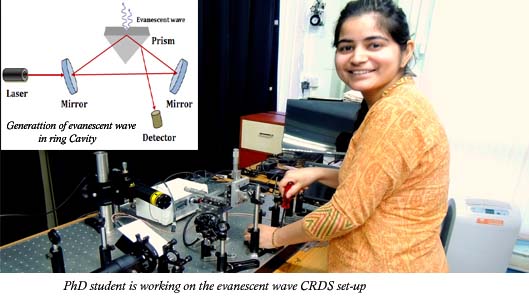 |
We are currently focusing on the fundamental understanding of the generation of evanescent waves as well as the development and implementation of an EW-CRDS technique as a probe of various dynamical interfacial processes in solid/liquid or solid/air interfaces to understand the following activities: (1) Fast kinetics and extent of the assembly of nanostructure materials on surfaces and interfaces. |
(4) Applications of Laser Spectroscopy for Environmental Monitoring & Atmospheric Chemistry
We are also working on the development and implementation of a new generation atmospheric chemical sensing technology for simultaneous real-time detection, quantification and continuous monitoring of numerous atmospherically relevant key molecules such as methane (CH4), nitrous oxide (N2O), nitrous acid (HONO), and acetylene (C2H2) in the Earth’s atmosphere with unprecedented sensitivity and specificity. We are using the cutting-edge mid-infrared QCL technology combined with a state-of-the-art high-finesse optical cavity-based CRDS technique.
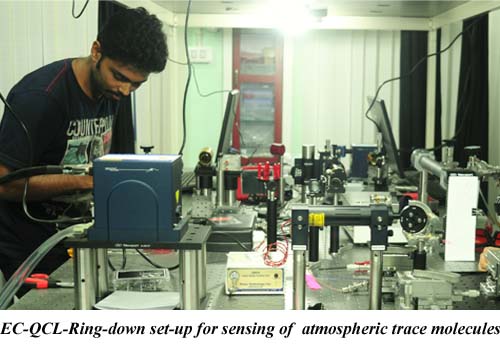
The high spectral resolution and broad tuning range of the mid-IR QC laser combined with the fast acquisition of the ring-down methodology will allow us ultra-high sensitivity and molecular selectivity when simultaneously monitoring several atmospheric species in real-time. This new development will also enable direct high-precision optical measurements of isotope ratios of many molecules at trace concentrations that can reveal important insights into atmospheric transport and chemistry. Thus the simultaneous high-resolution spectroscopic measurement of trace atmospheric species and their isotopologues in real-time provides a unique concept to explore the coupling of the biosphere-atmosphere exchange processes and new insight into isotope fractionation processes involved, which will markedly advance our understanding on the underlying processes. The following figure depicts a brief layout of the experimental setup for monitoring trace gases in the atmosphere.
(5) Applied Optics, Optical Physics, Quantum Sensing and Precision Metrology
In geometrical optics the physics of reflection of light from an interface is governed by the laws of geometrical optics. But, when the nature of the photons are considered as wave, in contrary to the classical particles, nonspecular reflection phenomena occurs, resulting in an effective beam shift at the interface. These shifts are usually called as Goos–Hänchen (GH) and Impert-Fedorov (IF) shifts. This is an exciting area of research that has produced a lot of interests in the last decade.
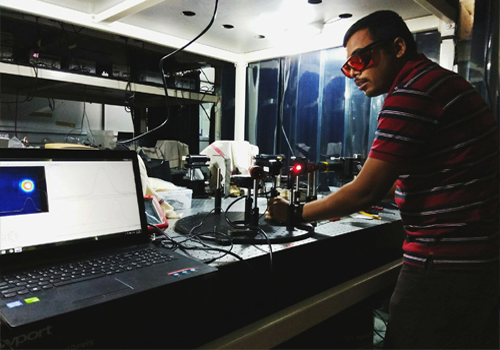 |
We are currently working on the optical beam shift phenomena of GH and IF effects for graphene, topological insulators and two-dimensional transition metal dichalcogenide (2D-TMDC) materials. These are a new class of materials in condensed matter physics which may lead to several new and interesting applications in various types of optical sensors and device technology. We have developed a general model to predict the GH and IF shifts on monolayer TMDC coated surfaces for a fundamental Gaussian beam of light. We predict the finite spatial and angular beam shifts for both partial reflection (PR) and total internal reflection (TIR) conditions and subsequently explore the unusual behaviour of beam shift effects near Brewster’s angle as well as the critical angle of incidence. Our findings shed light on the fundamental understanding of the optical beam shifts on 2D materials. We are also presently developing an experimental technique usually called quantum weak measurement technique for experimental observation of GH and IF shifts on 2D materials. |